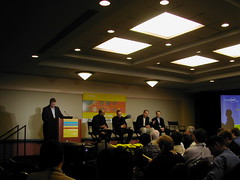A couple of months back I had the chance to sit and chat with a couple of the Lotus marketing executives, and they promised at the time that this would be the biggest, most announcement packed Lotusphere in years – maybe ever. Judging by the fact that they’ve had folks in the hall distributing small pamphlets that do nothing but summarize the various press releases, one would have to say that they’ve delivered, at least on the announcement fronts.
Whether it’s the Apple support, the SameTime connectivity with AIM/Google/Yahoo, the Hannover demos, the general availability (GA) of Workplace 2.6, or lots of impressive sounding marketshare growth metrics – news, unlike power outlets, has not been in short supply. Also making the press happy is the relatively aggressive tone adopted by Lotus execs here; in past, they’ve been more content to soft-pedal the competition with Microsoft, whereas Lotus GM Rhodin was candid about the fact that in that particular battle, he’s “playing to win.” All in all, it’s a show likely to get IBM/Lotus a lot of ink, one where the Fourth Estate doesn’t need to work to hard to meet their deadlines.
From a macro perspective, however, what I find intriguing is not the glut of product announcements themselves, but rather what’s behind them technically. For the past few years, folks from the Lotus camp have been messaging the “componentization” of their product stack – i.e. the deconstruction of some of the more monolithic pieces into more composable, reusable software assets. Spearheaded by ex-Lotus/current-DB2 GM Ambuj Goyal, this effort made for a good story, but had demonstrated few observable benefits prior to this iteration of the Lotus annual conference. But in the wake of Goyal’s tranfer to the information management side of the house, it may yet be Rhodin who benefits from this work.
To what degree we can attribute the volume of product announcements here directly to those componetization efforts is difficult to say, but one need look no further than the Workplace product – which draws on the Cloudscape (AKA Derby, AKA Sun DB) repository along with technology from Tivoli and WebSphere – to see what the eventual impact could be to the Lotus business. Rhodin touched on this during the Press/Analyst Q&A, citing the componentization as a critical factor in their ability to compete in a quickly changing market. Whether that’s quickly enough to allow Lotus to successfully steal marketshare from Microsoft while simultaneously fending off threats from more narrowly focused upstarts like JotSpot, SocialText and Zimbra is an open question, I think, but its tough to argue with double digit growth.
Either way, I think that componentization may be the context within which this entire show should be viewed. And in that light, Goyal should be taking a bow along with Rhodin, b/c that effort began on his watch.
Disclaimer: IBM/Lotus and Microsoft are clients of RedMonk, while JotSpot, SocialText and Zimbra are not.

